Days 41 through 45, Sarria to the Finish Line, Santiago ~113.6 km/70.5 mi
As I mentioned in my previous post, the final 100 kilometers (about 60 miles) of the Camino Francés is by far the most popular section of the Camino. Not only is this section where all other Camino routes culminate into one (“all roads lead to Santiago,”) but it is the stretch of trail that everyone must walk if they wish to receive the “Compostela,” the accreditation of the pilgrimage to the Tomb of St. James, beautifully personalized and inscribed in Latin.
Sarria is the town closest to the final 100 km. It’s about 13km (7 mi) out from the official “100 km” marker. This final stretch (100 km, or 200km for those riding the Camino on bikes) must be documented by obtaining two stamps per day in an official credential book. These stamps can be obtained from cafes, restaurants, shops or albergues, but there must be two per day at intervals along the Way.
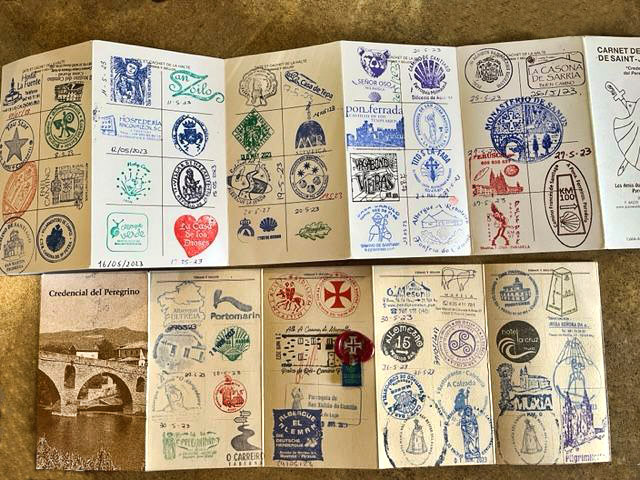
Stamps on my “Credencial del Peregrino” from the places I passed through certify that I have been there. I filled up two booklets, front and back.
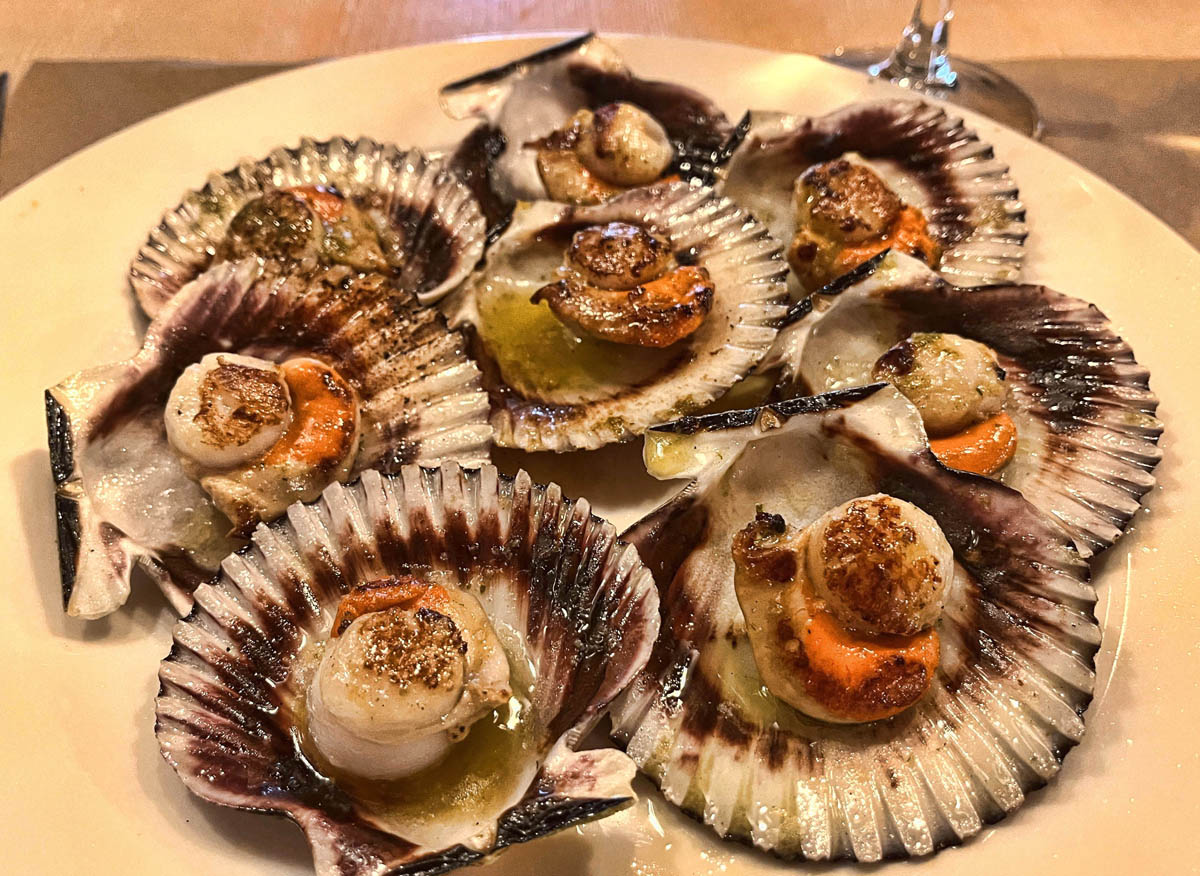
Grilled scallops at A Travesía dos Soños. After seeing so many scallop shells adorning pilgrims and marking the way, it feels almost sacrilege to eat them!
Note scallops served outside the US typically have the coral-colored “roe” still attached. Even though the roe is more flavorful than the actual scallop, it is often removed for “aesthetic reasons.”
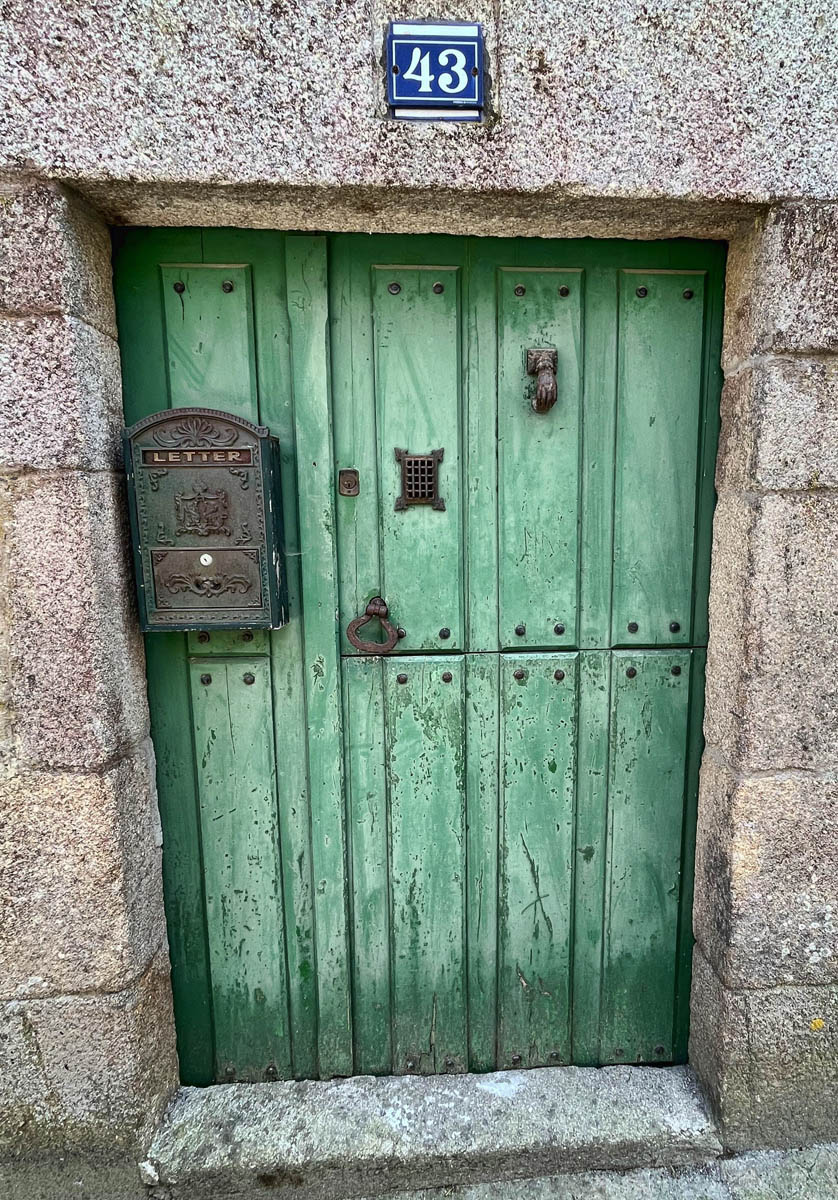
I must have taken 300 photos of beautiful doors along the Camino. At least one had to make the blog!
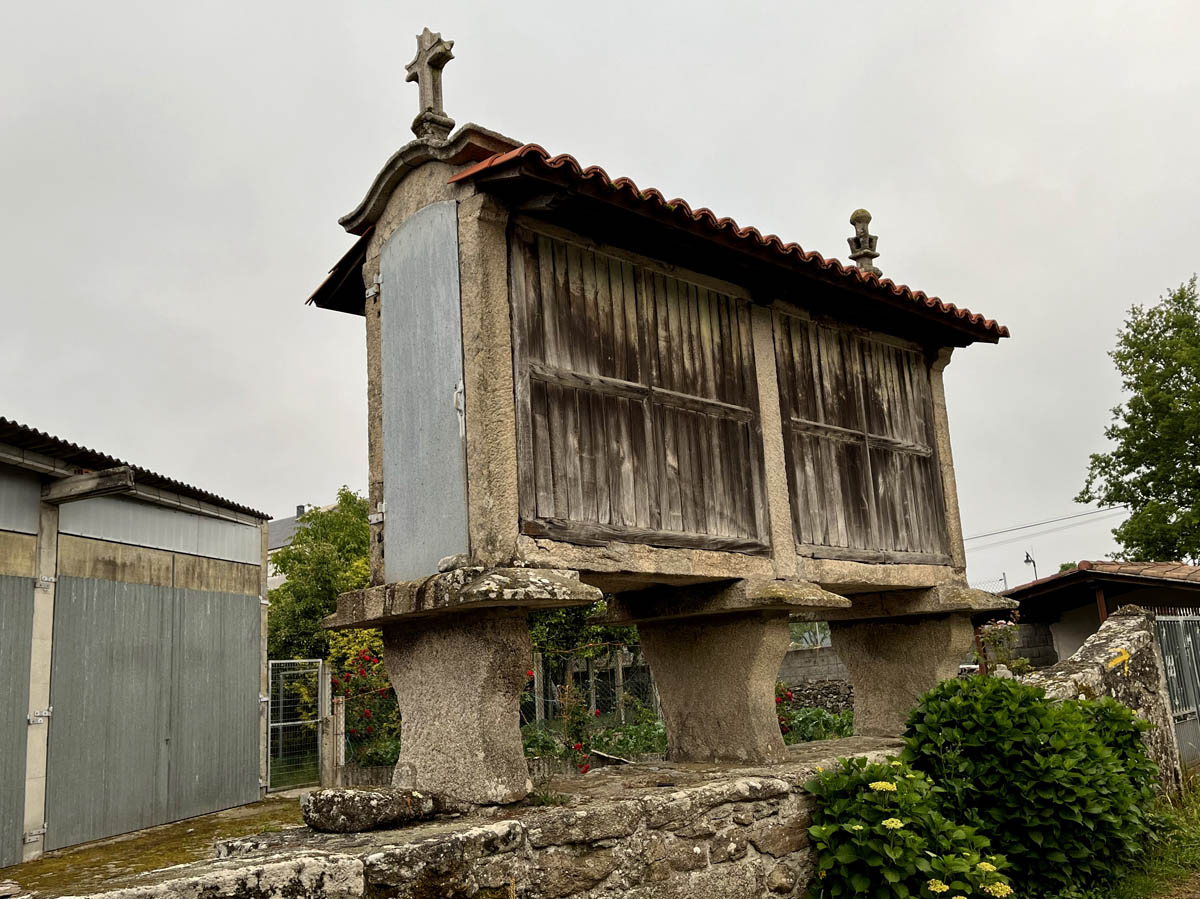
Another feature I must have taken a hundred photos of were the “Horreros,” (pronounced like “Oreo,” the cookie.) They function as corn cribs with slatted walls for ventilation, and a foundation designed to prevent rodents from climbing up. But with their finials and crosses of varying designs, they are an art form in their own right.
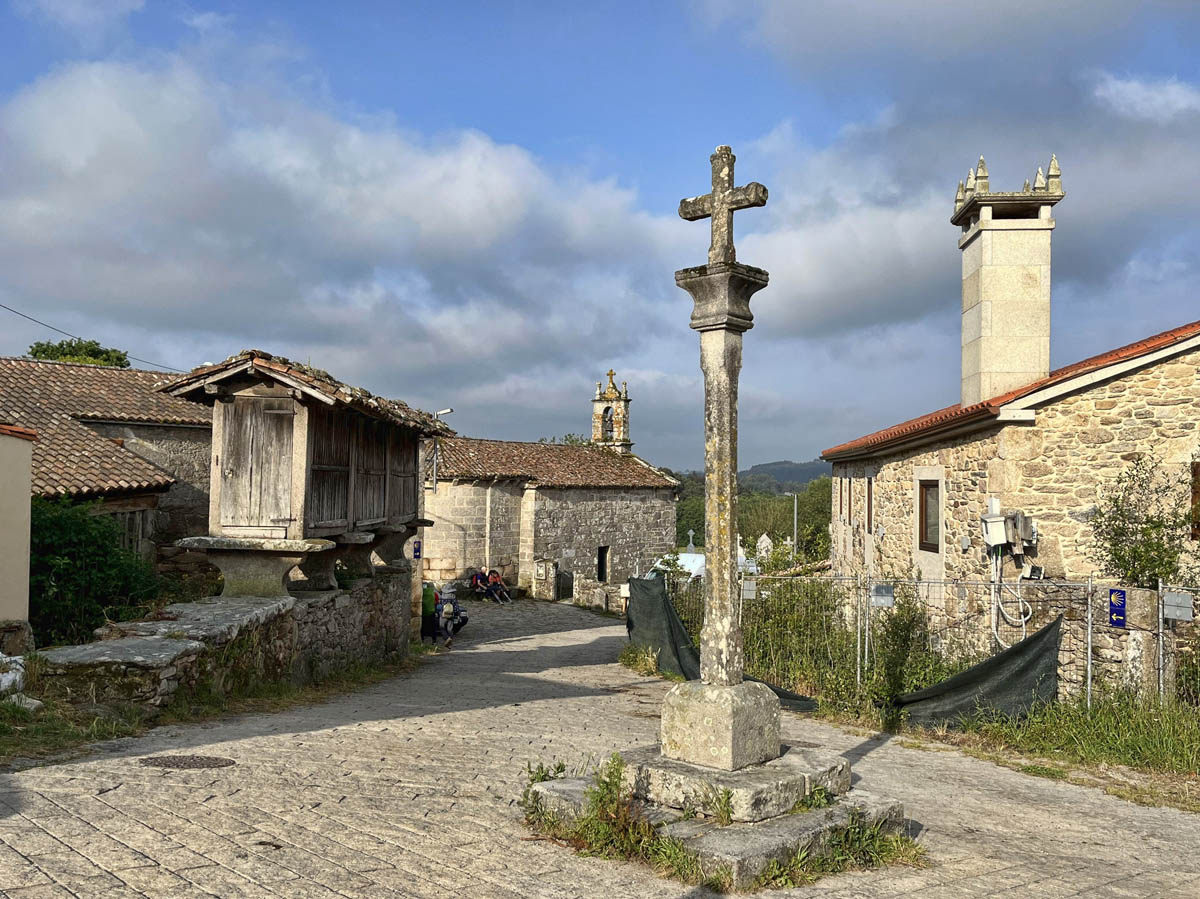
Other symbols often seen along the Camino are the cruceiros, stone crosses or crucifixes. These Cruceiros, Galician word for “intersections,” are said to protect and direct travelers on their way to Santiago.
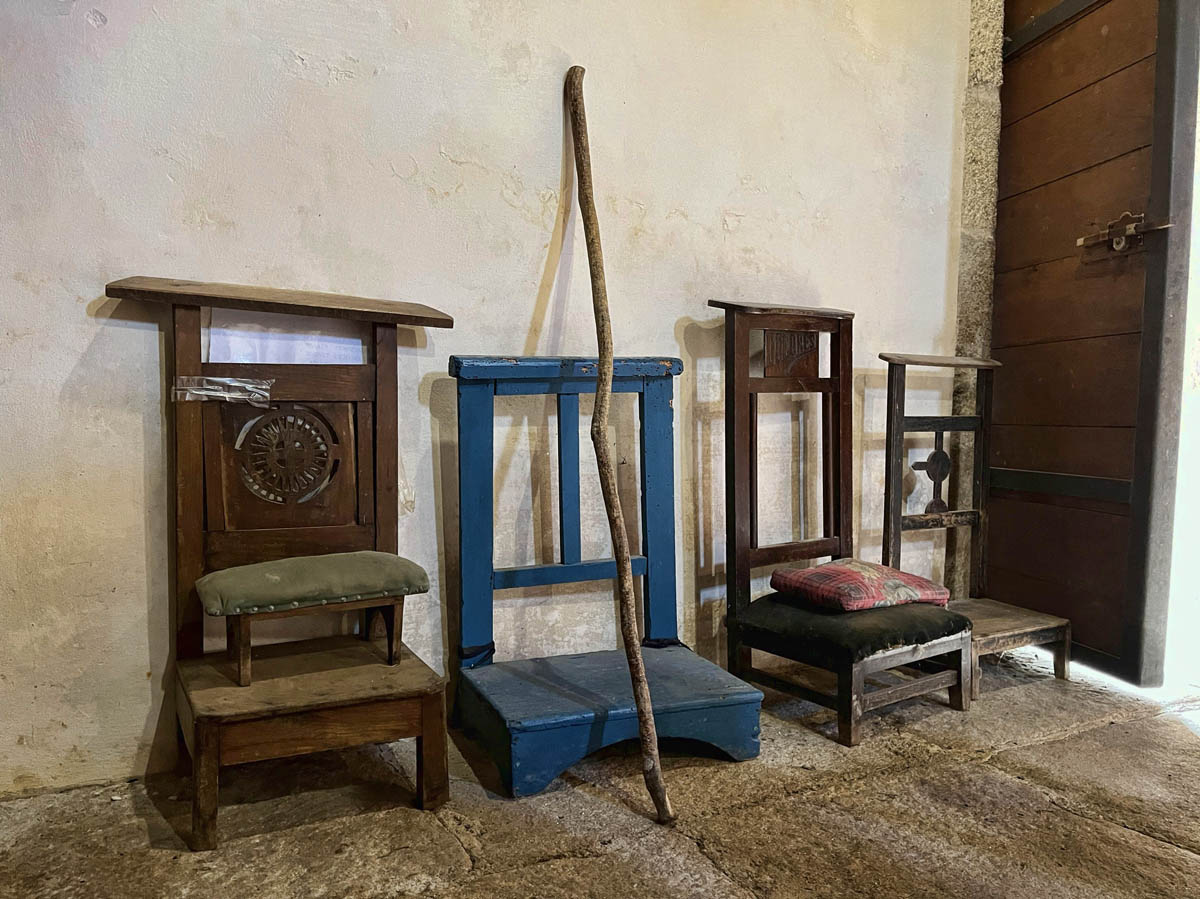
Never pass up the opportunity for a peek inside the churches along the Camino. No matter how small, there is always something of interest inside.
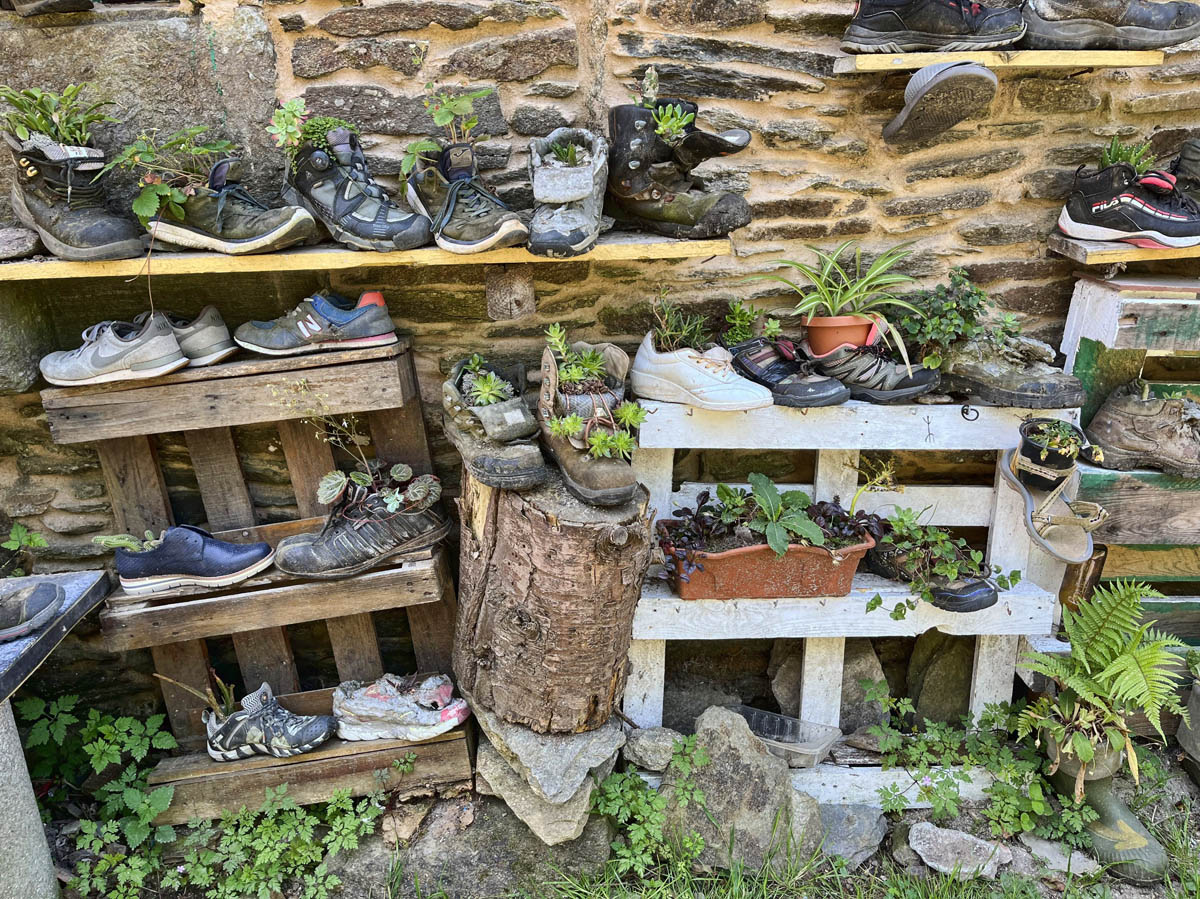
Where old “soles” go to die…
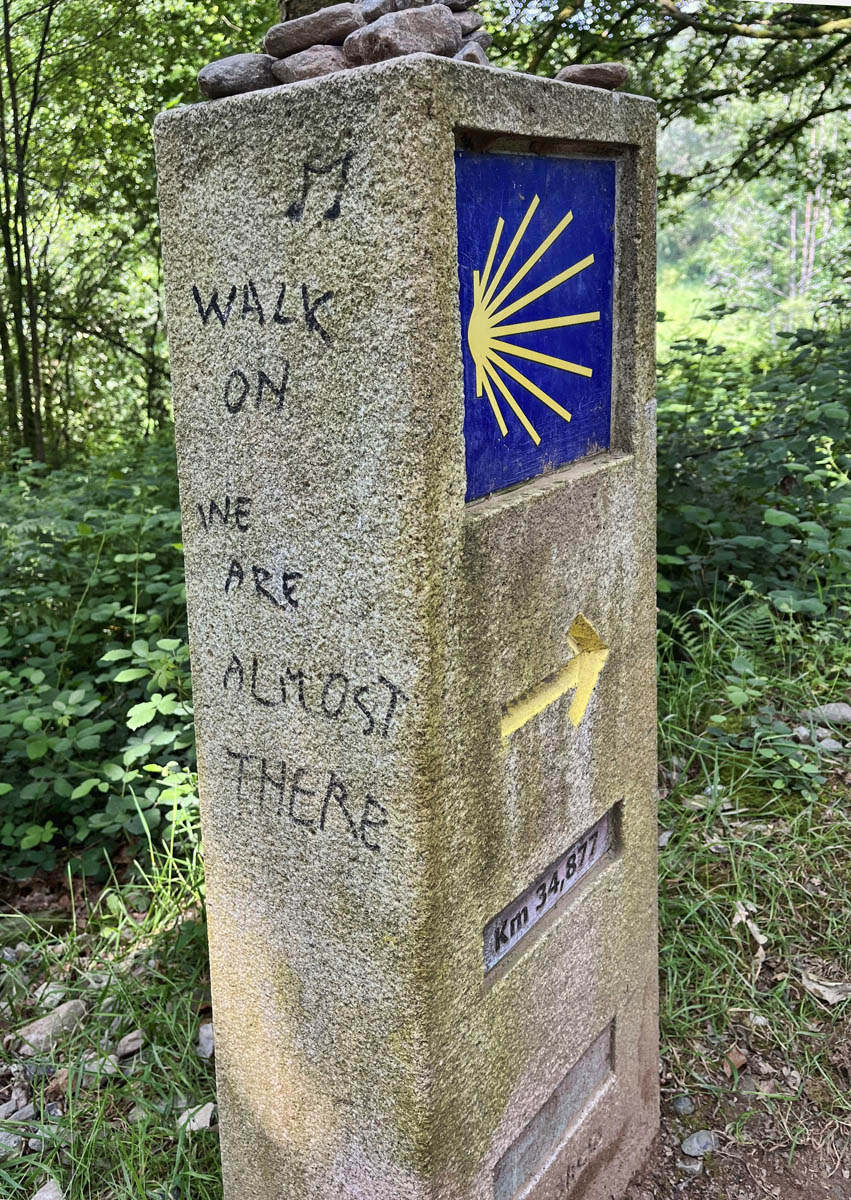
As I have stated before, I am not an advocate of graffiti. But the “we” in this one, along with the musical note, gave me the feeling of being guided.
I have read that anywhere from 33% to 50% of all pilgrims begin their Camino in Sarria. This means not only individual travelers, but hoards of tour groups as well. There is a derogatory term for these types of groups who drop pilgrims off by the bus-load at the trail head, or worse yet, dropping them along the way to collect their stamps. They are referred to as “Tourigrinos,” a slang mash-up between tourist and the word peregrino, the Spanish word for pilgrim.
So from all indications, the traffic up ahead was about to double. I was feeling quite a bit of apprehension the morning I departed Sarria. Marcella, the owner of La Posada where I stayed the night before, has walked the Camino seven times. She told me to brace myself and just try to accept it as all part of the Camino experience.
Marcella told me on my way out of town, there was a bridge….a Roman bridge (said rolling her r’s with extra emphasis on the word “Roman” in her deep, Spanish voice.) She told me to stop there, place my hands on the stones, and draw strength and courage to carry on for my remaining five days in spite of the changes and challenges ahead.
When I arrived at the bridge early that morning, I placed both hands on the ancient stones, as Marcella had instructed. I stood for a meditative moment to contemplate the effort it took to construct this bridge in ancient times…how they must have struggled, stone by stone…but then I realized I had an audience waiting for me to hurry up and get out of the way of their photos!
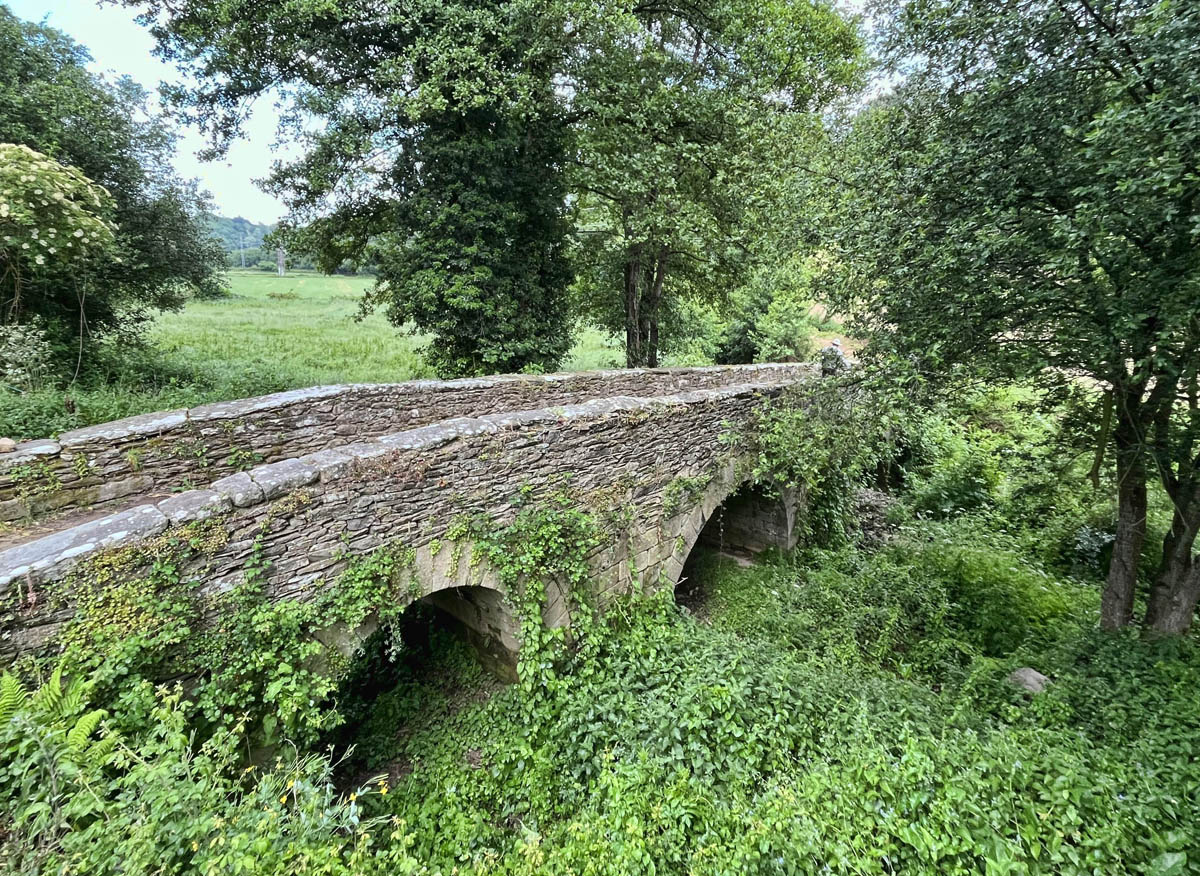
Pilgrims must cross this bridge leaving the town of Sarria. I stopped for a moment of “reflection…”

Then I realized I was clogging up traffic!
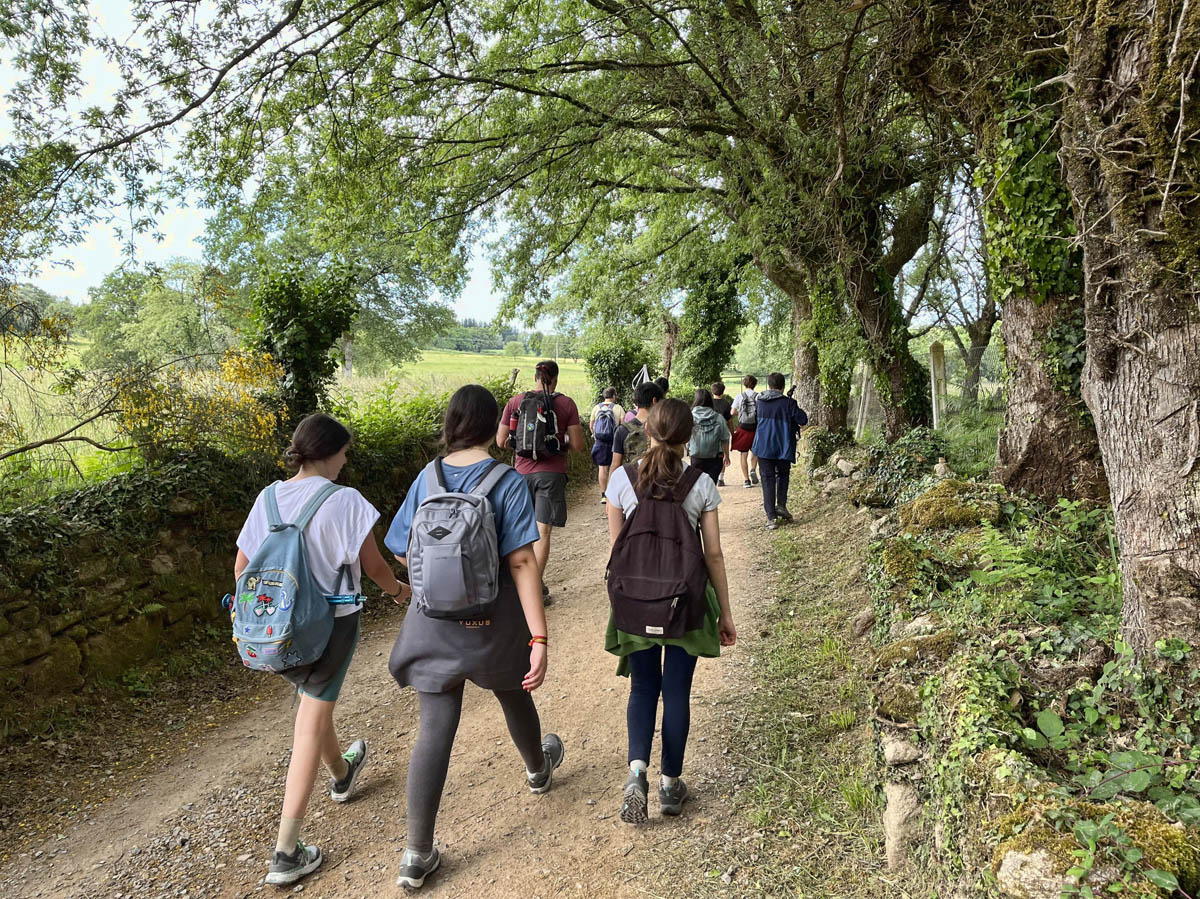
Not used to seeing this many people on the trail! It feels like the first day of school!
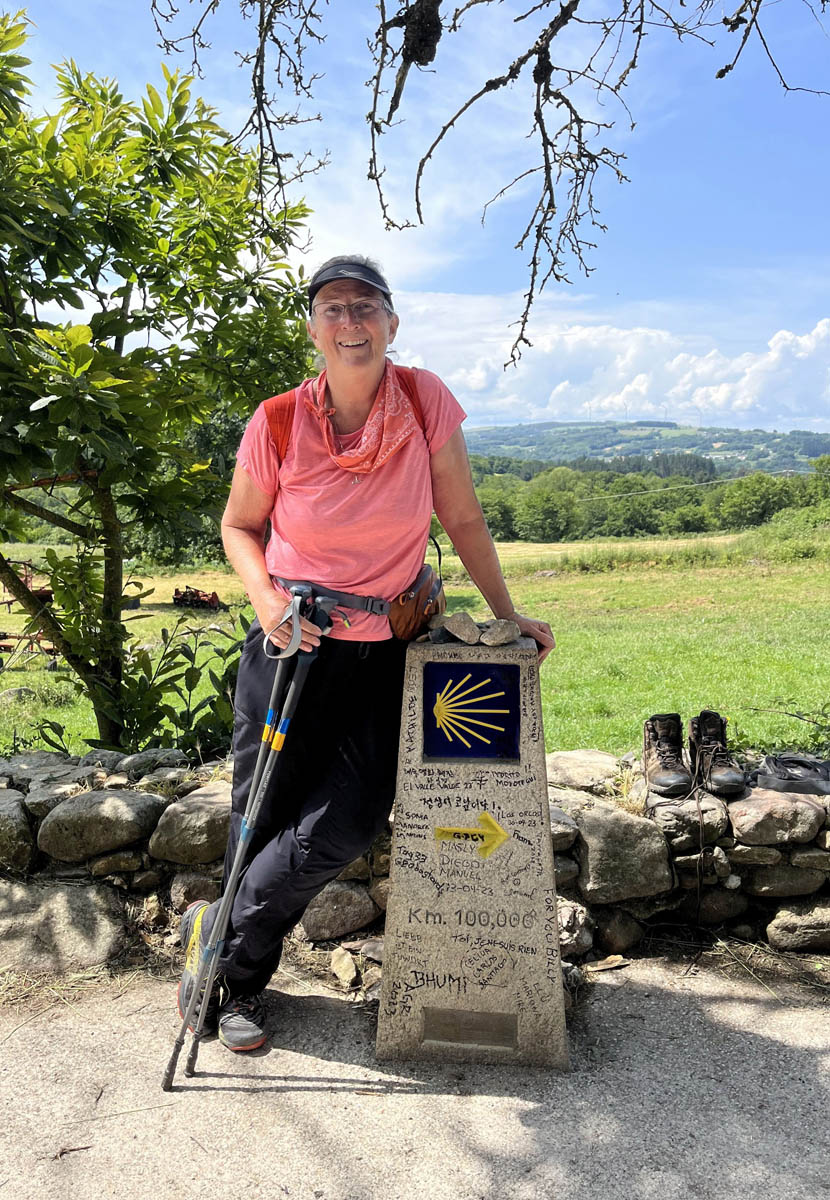
Ah, finally, the 100 km marker, the most “graffiti-ed” marker along the Camino! Something about seeing that third digit drop off and now counting down from 99 gave me the feeling that I just might finish this thing!
I was in shock as they just kept coming. I pulled out my phone and began speaking a “stream of consciousness” dictation into Notepad… “So many more on the trail. So many pale-skinned legs. So many pairs of brand new shoes. So many American voices talking about sports teams and office politics. Baseball cap wearing adolescent boys. Flag carrying school groups. So many kids! One being pushed up the hill in a stroller! People smelling of fresh perfumed laundry detergent. A guy in a ‘singlet,’ his girlfriend looking like an aerobics instructor. He’s carrying an entire boom box, blaring from atop his shoulder.”
Gone forever were my quiet, contemplative walks, I feared. I had been walking for 40 days. I was weary. They were all brand new. I sat on a stone fence to await a break in the crowds, but I soon realized there was no break coming. It was “go now or not at all.” It’s easy to understand why some walk 690 km and decide to stop short of the last 100.
Thankfully, it did get much better. After that first day, the “human slinky” began to spread out. I could breathe once again, and in fact, even enjoyed some respectable distances of solitude among the tall eucalyptus forests.

These are the steps leading into the town of Portomarin, the “newest oldest” town along the Camino. The Rio Miño was dammed in 1956, so to avoid losing the town in the flood, they relocated the more significant buildings like the church to higher ground, stone by stone. The remaining part of the town is new construction, while some of the older parts are now submerged in the reservoir.
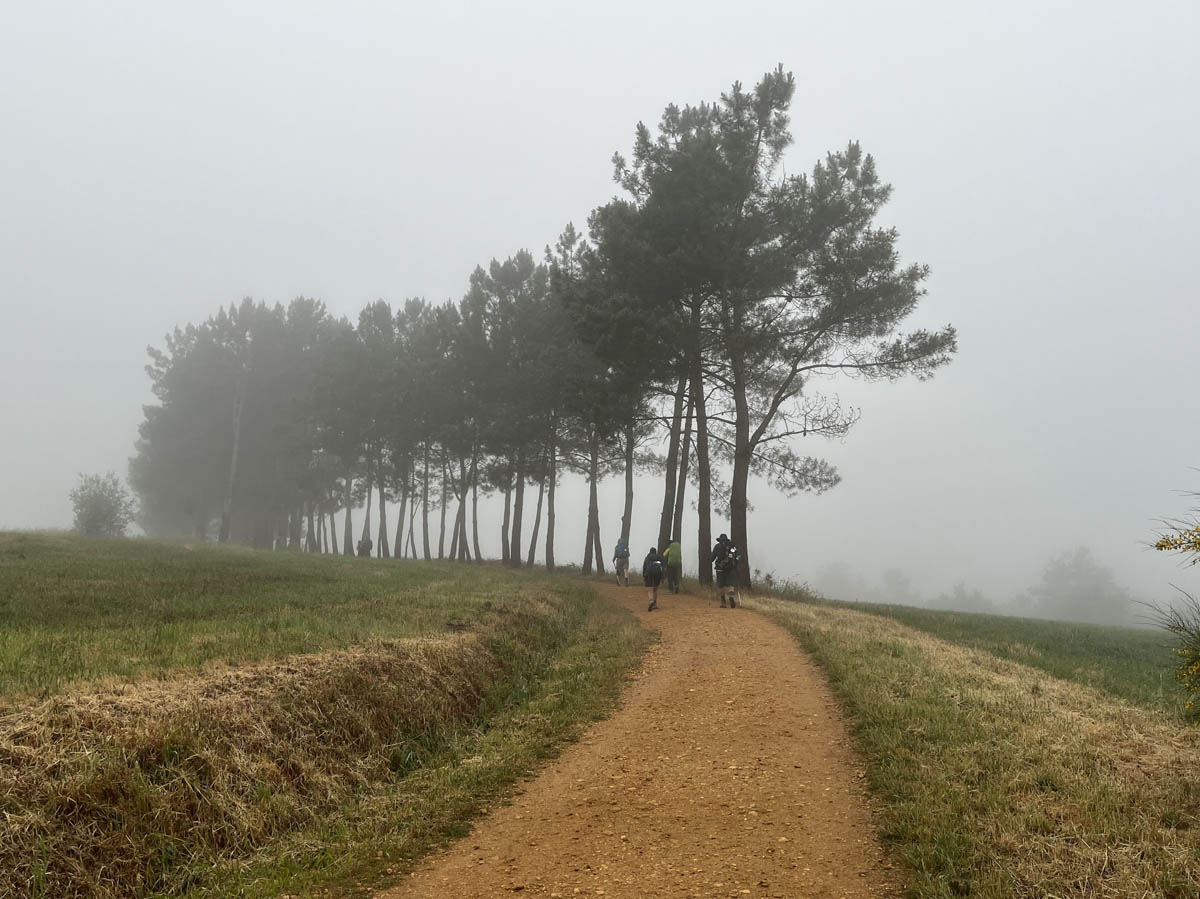
Galicia has a lot of rainfall, therefore the humidity is quite high. Mornings would often be foggy.
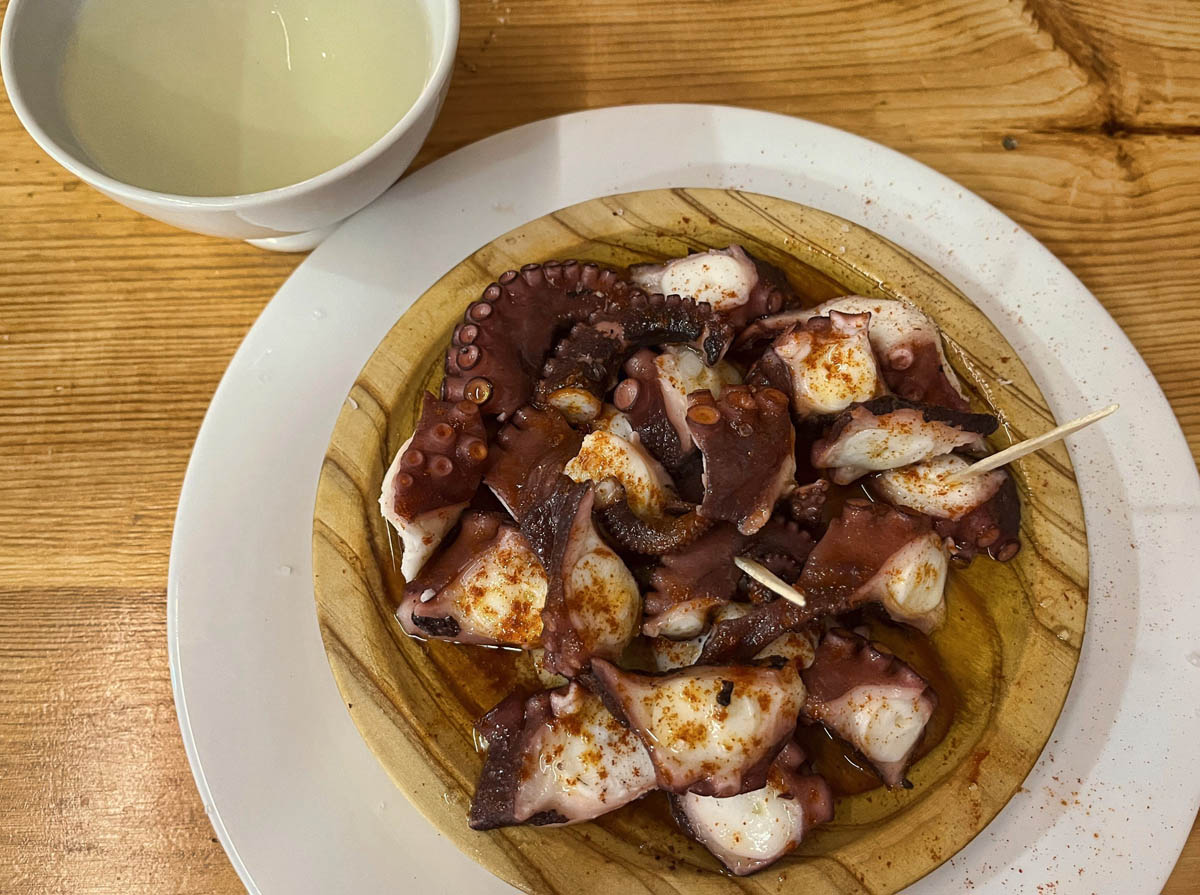
The town of Melide is known for its “pulpo,” or octopus, not because it is close to the sea, but because it has a long tradition of being for sale in their Thursday market. it is served on a wooden plate with a drizzle of olive oil, and sprinkle of paprika. Tradition also includes a “bowl” of the local Riberio wine.
I stopped eating octopus after I started scuba diving, after seeing what intelligent creatures they are. I regretted partaking just for the “known for” factor.
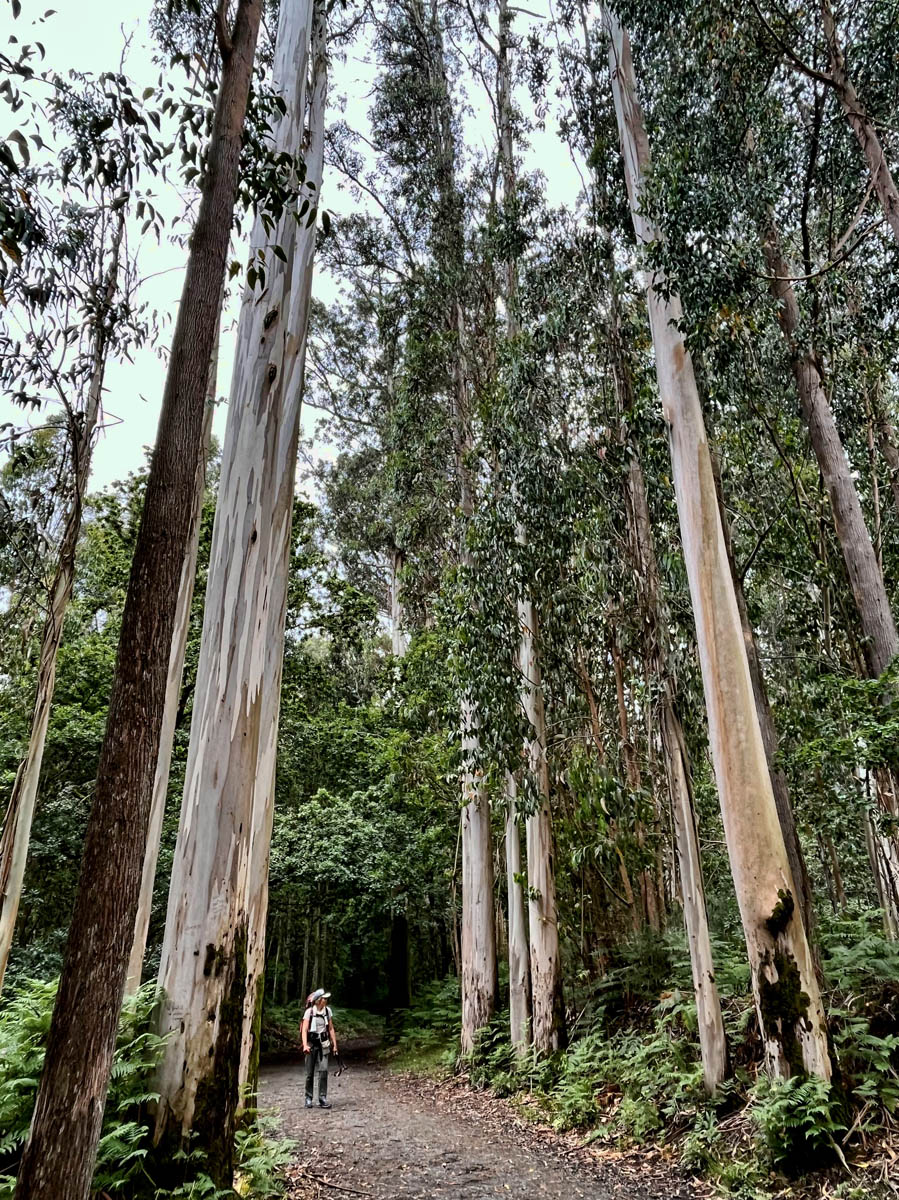
Although the eucalyptus tree is not native to Spain, it is certainly ubiquitous, as fields have been cultivated for a fast-growing wood source. The fragrance is intoxicating, especially when coming upon a grove that has been recently harvested. It smelled so fantastic, I sat on a tree stump for a good long while just deep breathing, filling my lungs with the menthol-like soothing aroma.
The final day into Santiago was my biggest culture shock yet, as I turned a corner to find a group of pilgrims staring across a field. I scanned the horizon to see what they were looking at, only to realize it was the orange wind sock at the end of the runway of the Santiago airport. It wouldn’t be long until I began hearing the roar of jet engines overhead, reminding me that those planes were likely filled with pilgrims like me, many having just completed a life altering experience, now on their way back to their previous lives of families, jobs, roles and responsibilities left behind. It was a sinking feeling.
That last morning felt like being sucked down into a vortex of pilgrims funneling down into the old town of Santiago. The closer I got, the bigger the crowd, as we pilgrims were now joined by locals on their morning commute. I was having a real conflict in my mind between “Speed up! Hurry and get there!” to “Slow down, you don’t want this moment to end!”
Several days prior over dinner, my new friend Roger from Scotland’s Shetland Islands talked of the bagpiper who stands in the arch at the bottom of the stairs just before entering Obradoiro Square, the end point of the Camino in front of Santiago’s famous cathedral. He said with his beautiful Scottish accent, “Before you reach the square, you’ll hear the sound of those pipes a callin’ ya home.” After all, Galicia has Celtic ties. And he was right. The minute I reached the ramp leading down to the staircase, I heard the lone piper calling….and the tears began to flow.
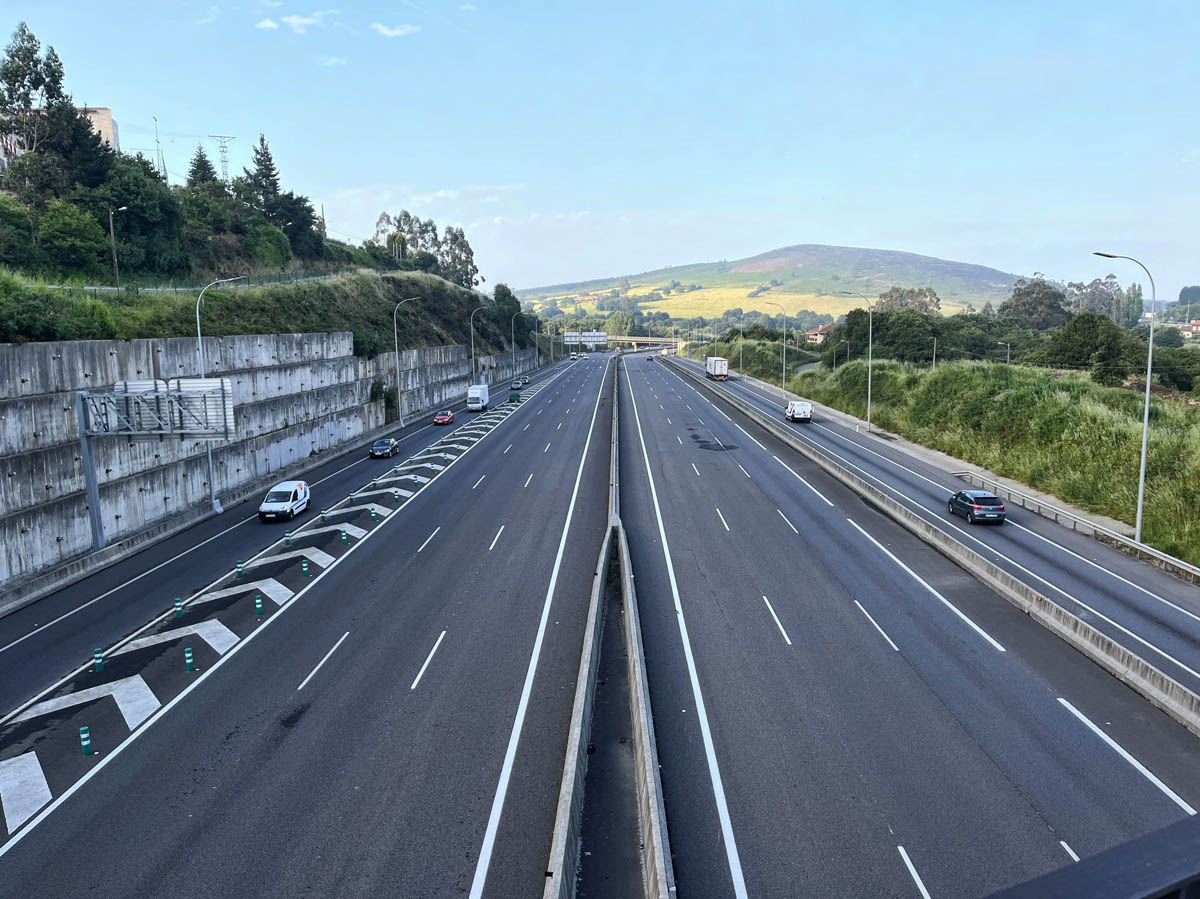
The sobering reality, as I enter Santiago on my final day.

So bittersweet! Elated to have made it, but that nagging “What now?” voice is growing ever louder.

Long time tradition of a lone piper, welcoming Pilgrims into Plaza del Obradoiro, end point of the Camino de Santiago.
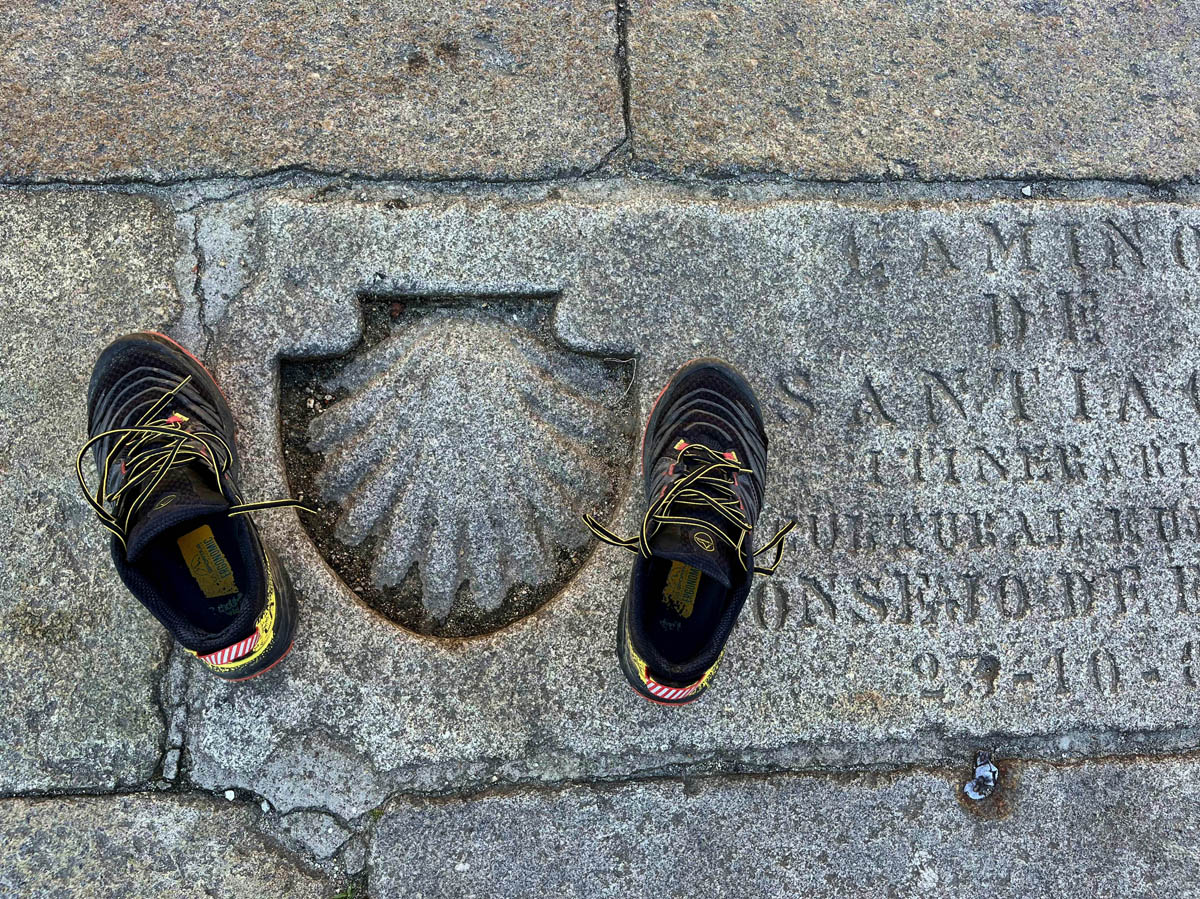
In the center of Obradoiro Square is “the shell.” This is “ground zero” for all those pilgrims who have arrived from over 130 countries.
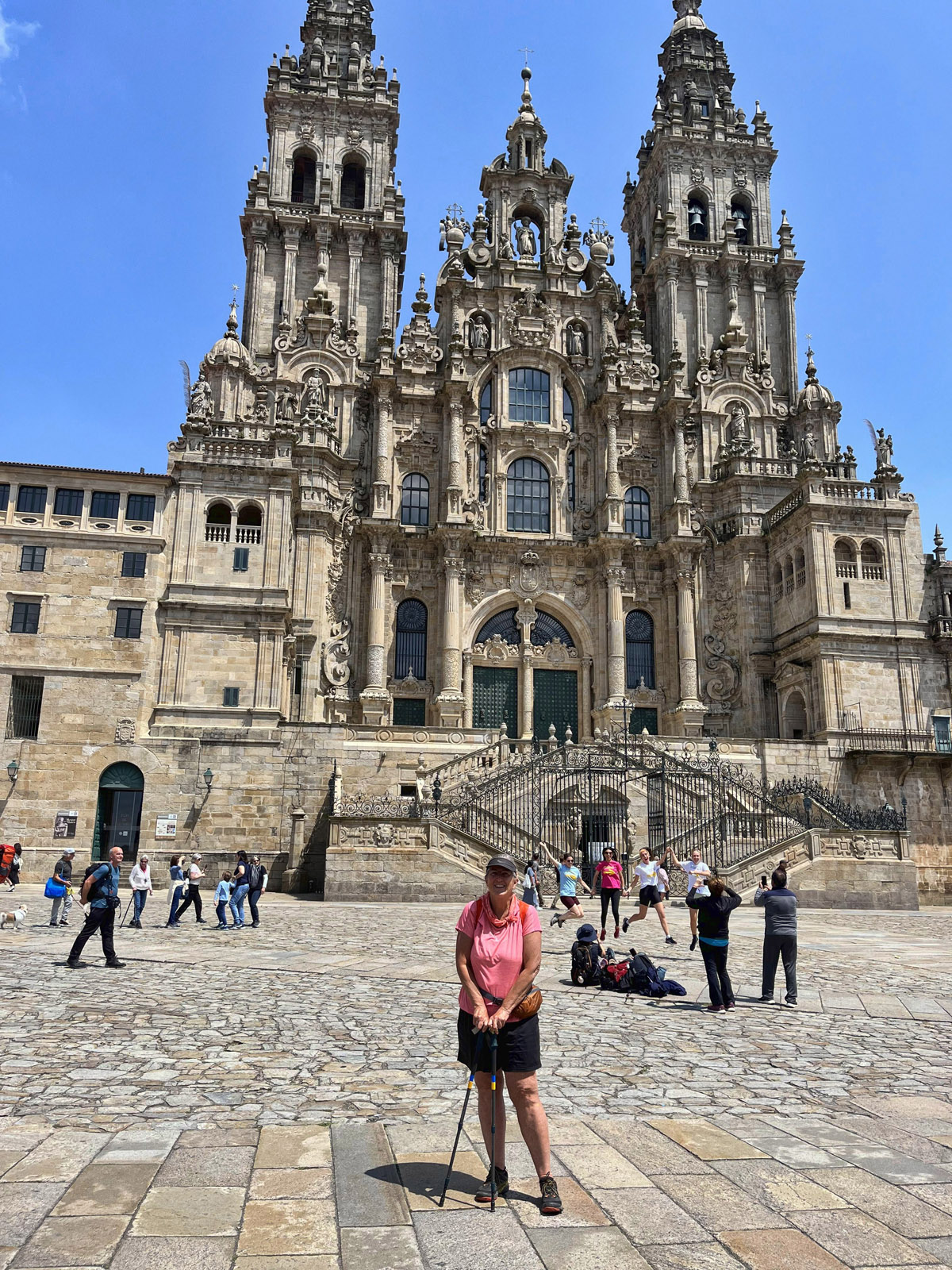
At Last…tough to explain how it felt to finally stand here! My heart was pounding and my knees, shaking.

Next stop, the Pilgrim Office around the corner and down the block. There is a line, but it moves fast. “Welcome to Santiago” was music to my ears!

Santiago is such a vibrant city with lots of outdoor space.
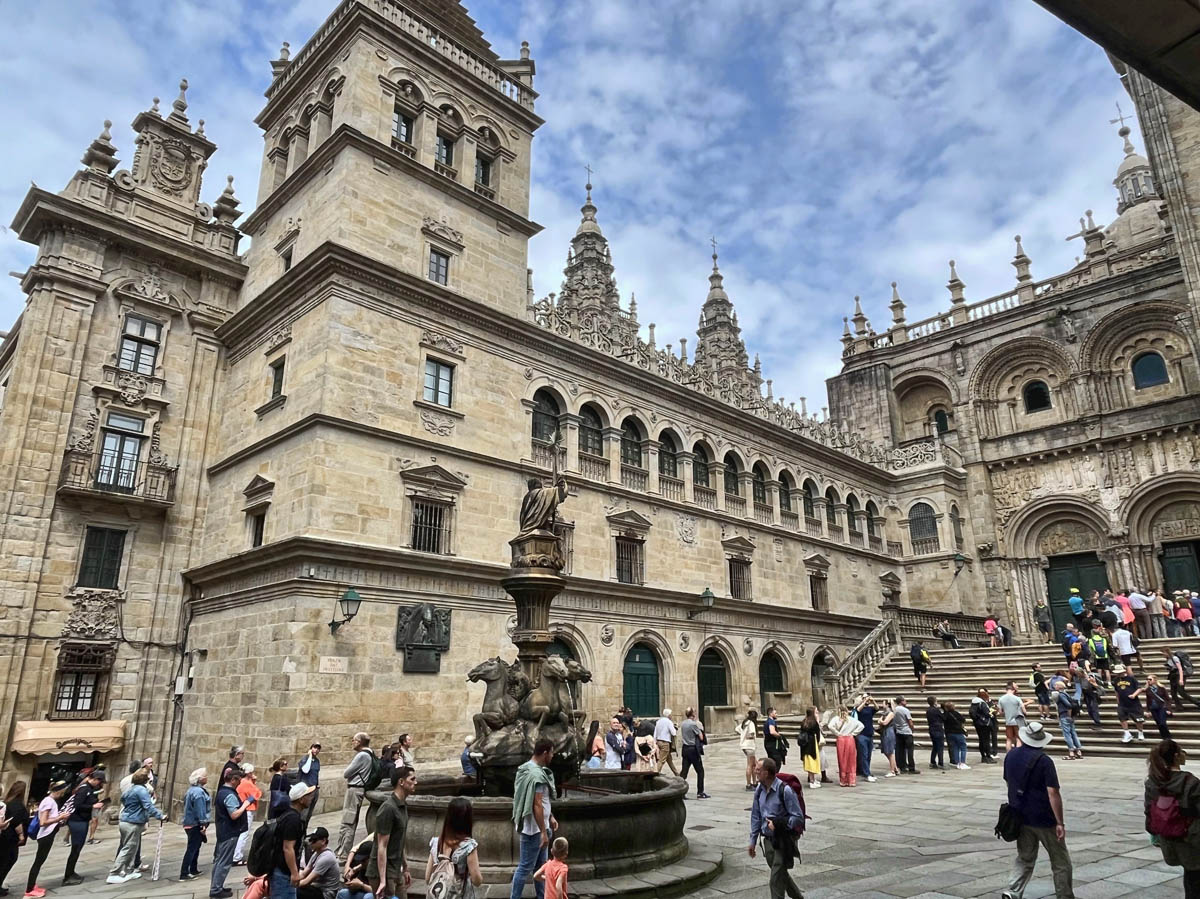
Get to the cathedral early, or time other than Mass to avoid this long line!
After reaching the center of Obradoiro Square, I finally got myself composed. The tears were replaced with jubilation, as I began seeing people I hadn’t seen in weeks! It was like the mother of all homecomings! But the tears started all over again as soon as I reached the Pilgrim’s Office, where pilgrims go to collect their compostela. I started blubbering again like a baby when the official in the Pilgrims Office said “Welcome to Santiago! You have come a very long way.”
I had purposefully avoided studying others photos or videos of the actual Plaza del Obradoiro, the square in front of the Cathedral de Santiago de Compostela, that marks the center of old town Santiago. I wanted to see it “live” for the first time. I struggle for words to describe the emotions I felt this morning, after walking toward this destination for 44 days. So bittersweet! I equated it to getting off a 45 day rollercoaster, then stumbling around for direction.
There’s an unofficial process when you arrive into the Plaza del Obradoiro. Pilgrims jockey for position amidst large tour groups to reach “the shell” (shell in the middle of the square embossed in the concrete.) People are either taking your photo, or you are offering to take theirs. There is a lot going on. There are tears, hugs, laughter, jubilation. Packs, poles, and sometimes even bicycles are being hoisted over the heads of pilgrims in a sign of victory. Once the requisite photos have been taken, one is typically ushered off by their fellow pilgrims to the Pilgrim Office, a couple of blocks away to stand in line for the highly anticipated issuing of the compostela. If one has stamps in the credential books to prove they started their walk in SJPP, a “distance certificate” is also offered. It’s like graduation day all over again at 68 years old!
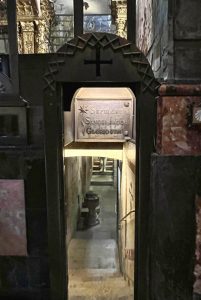
Once you have secured your seat for the Pilgrim’s Mass, have your friends save your seat while you walk around the cathedral. Down these stairs in the crypt are the remains of St James.
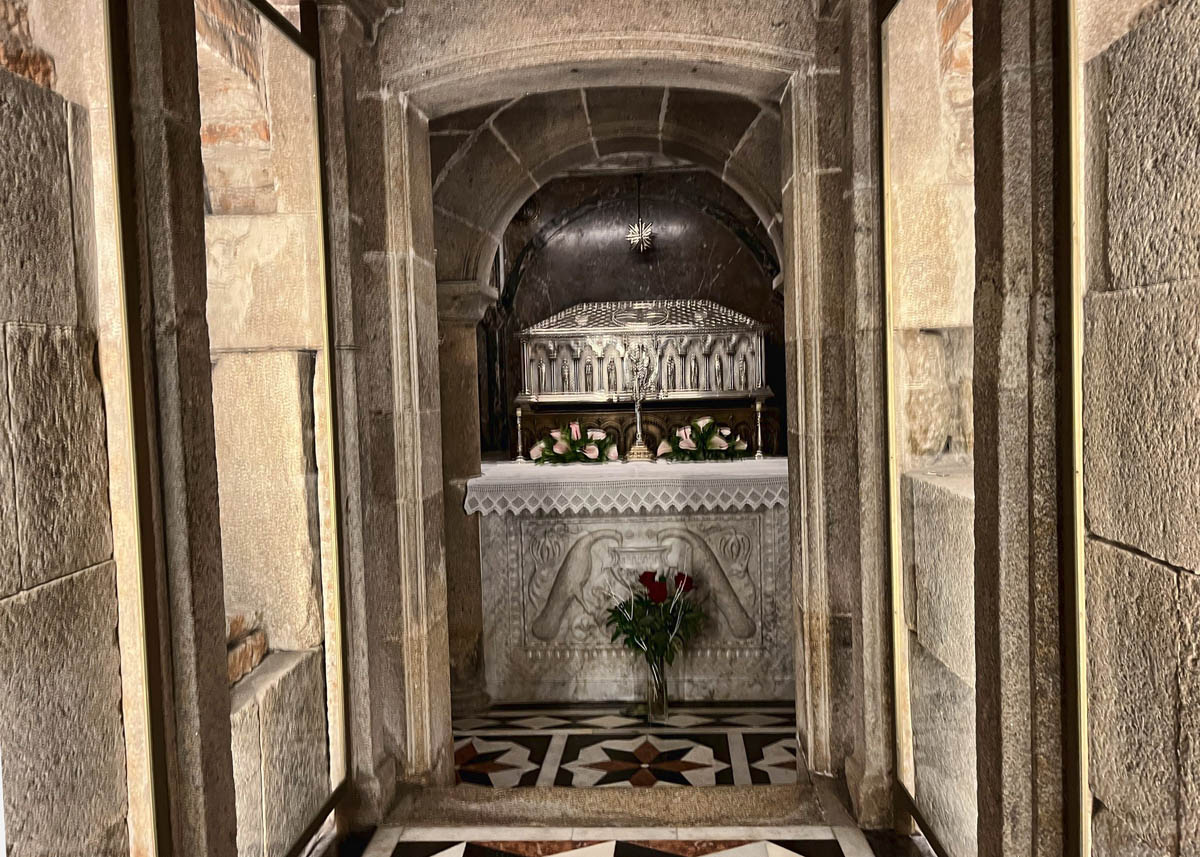
St. James Tomb, the reputed location of the apostle’s remains.
If one has arrived early of a morning, the next step after all the photos and paperwork are done, is to head inside the cathedral for the 12 Noon Pilgrim’s Mass. Again, not being a religious person, “attending mass” is not something typically on my list of “must dos.” But this is different. It feels like a culmination of all the emotions rolled into one. Sitting there on the pew among fellow pilgrims. Though the Mass begins at 12:00pm, if you haven’t claimed a seat by 11:00am, you are not going to get one. And standing is risky, because you may be ushered out of the aisles, depending on whether or not the Botofumerio swings that day.
The botofumario, or giant censer (incense burner) is one of the most iconic symbols of the Camino. This ornate silver-plated urn Weighs 53kg (117 lbs) and measures almost 5 ft tall. It’s suspended from the center dome by a rope and pulley system. If you think of the cathedral layout in the shape of a cross, the botafumerio swings from side to side along the horizontal axis in a wide arc, suspended by ropes from a pulley system in the dome overhead. At its highest arc, it almost reaches the ceiling of the transept. It’s been clocked to reach speeds over 60km/h (40mph) as the sweet, heady smoke of the incense wafts through the air.
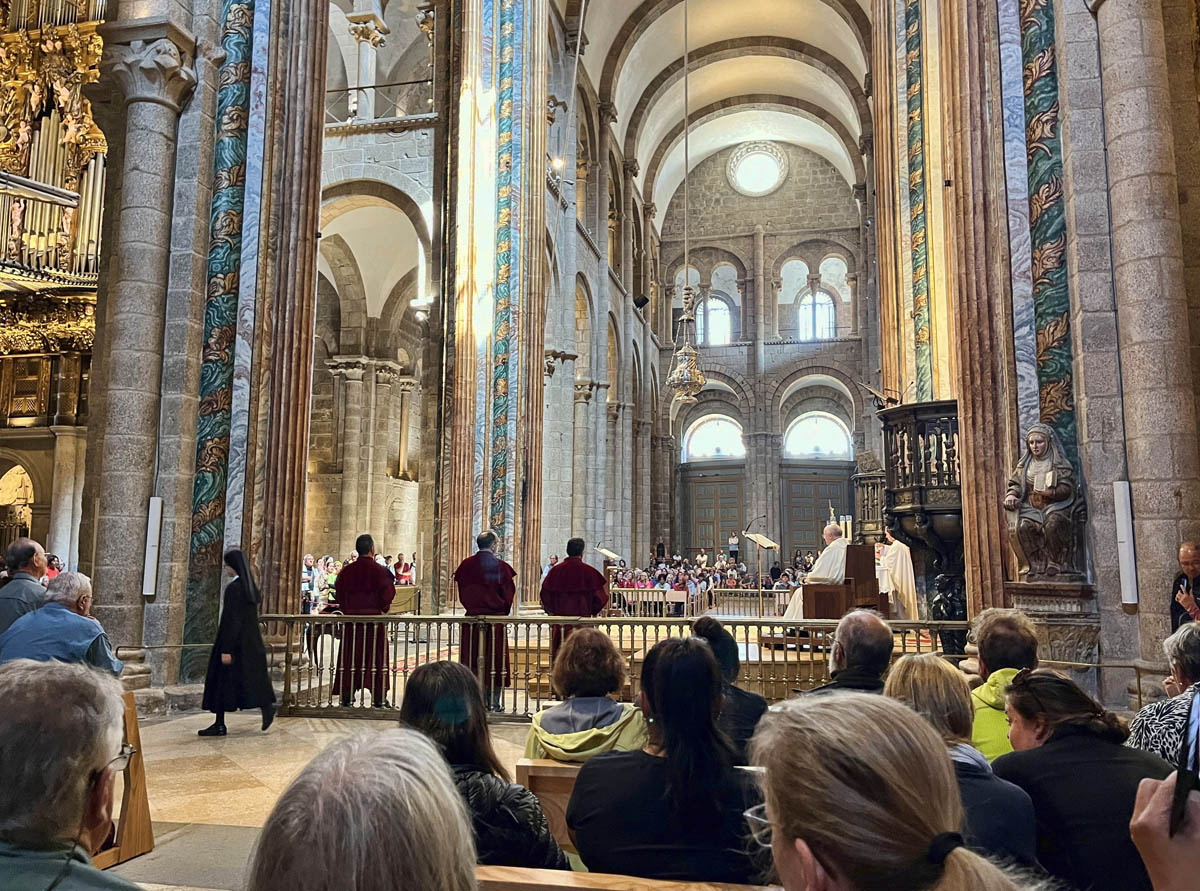
There is no guarantee the botafumerio will “swing” during every Mass. One indication is if you see the men in the red robes line up around the pulpit, and the nun in the far left of the frame is closing the ropes to restrict access to the botafumerio’s path.

In the lower left of the photo are the eight red-robed “tiraboleiros” responsible for making the botafumerio swing.
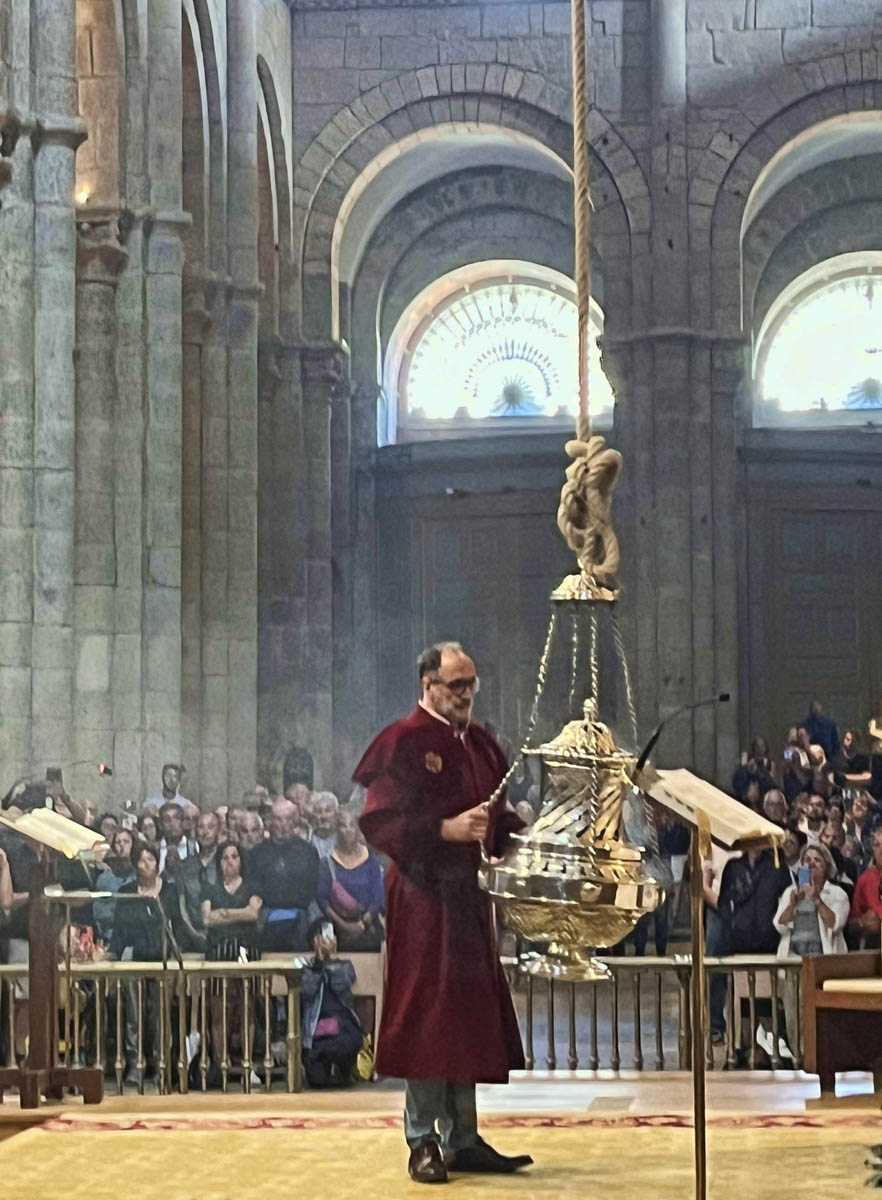
This guy is responsible for “putting on the brakes.” He catches the rope, and it swings around him to a stop.

Immediately after the event, the priests make their exit.
There is no guarantee there will be a “performance” of the botafumerio. There was a time when it was a regular feature of the Friday Pilgrim’s Mass. But the performance is costly. It requires not only incense and regular maintenance, but a troop of eight red-robed men called “tiraboleiros” to pull the ropes, an action to increase the oscillation of the censer. These days, the only guarantee is to attend one of the “high holidays,” or have the luck of the draw to arrive on a day when a tour group has paid €450 for a front row pew for their clients. One slight clue, if the front two pews on the side are blocked off, you may be in luck!
I’ve been in churches, cathedrals and mosques all over the world, but none more exhilarating than this experience. The thrill was made even more special by occurring on the same morning as I completed my 45 day Camino.
If you would like to see the botafumerio in action, here is a very brief video I took. While we are asked at the beginning of the service not to film the Mass, we are told it is okay to film the swinging of the botafumaerio, which happens at the end of the service following communion (around the 45 minute mark.) At 1:03 seconds of this brief video, you can hear my friend Janice from Texas exclaim, “Oh, my GAWD!”

This was my “graduation celebration” after Mass. After such an event-filled morning, I was starving!

I hung around for several days exploring Santiago. I took a tour of the cathedral rooftop, which was spectacular, but not for the faint of heart. We were allowed to walk all over the roof, but there were no guardrails! Beautiful, but acrophobes, beware!
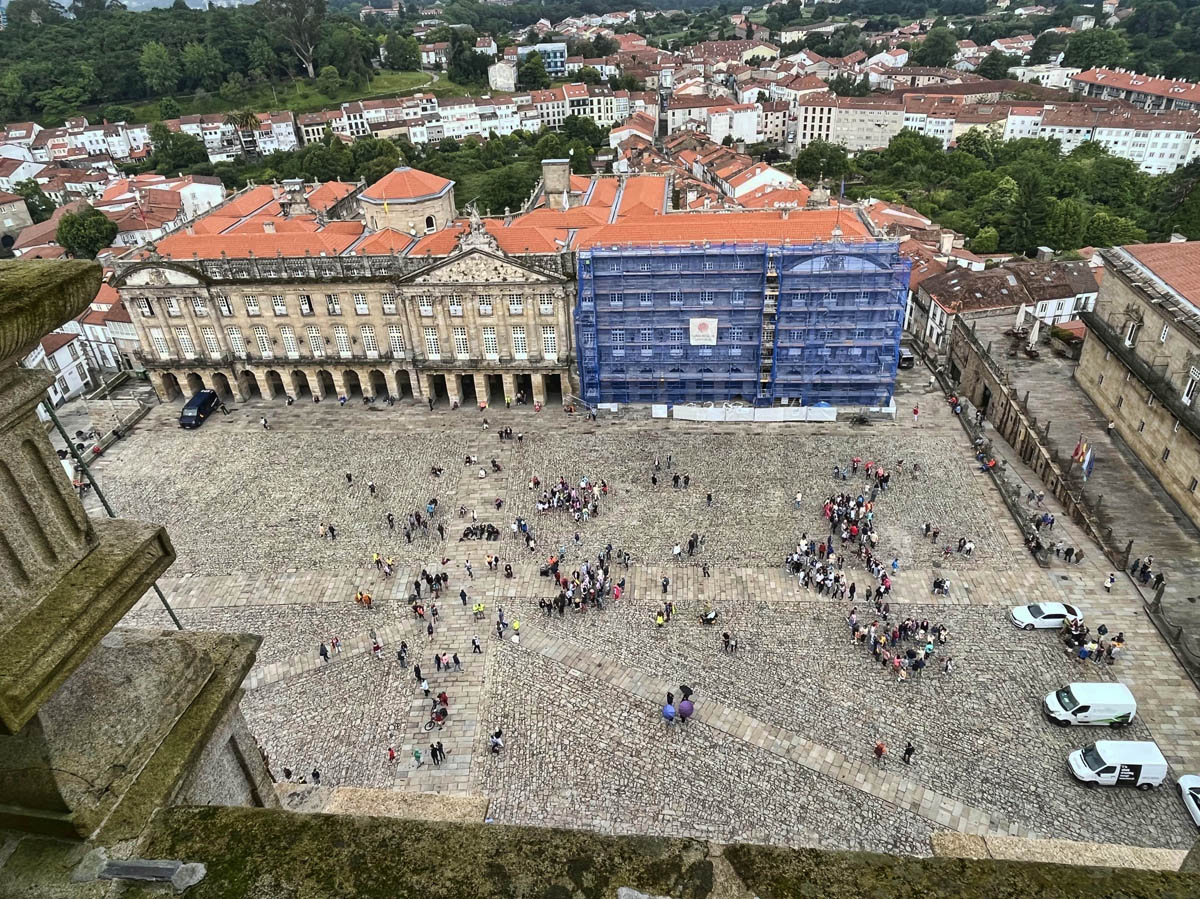
Looking down into Obradoiro Square, it was fun watching the pilgrims celebrate. If you notice just above the center axis in the stone pattern, there is a “black blob.” This is a group of five young South Koreans lying in the square. They were still there when I came down, so they were very excited to see the photo, which I “air dropped” to them.
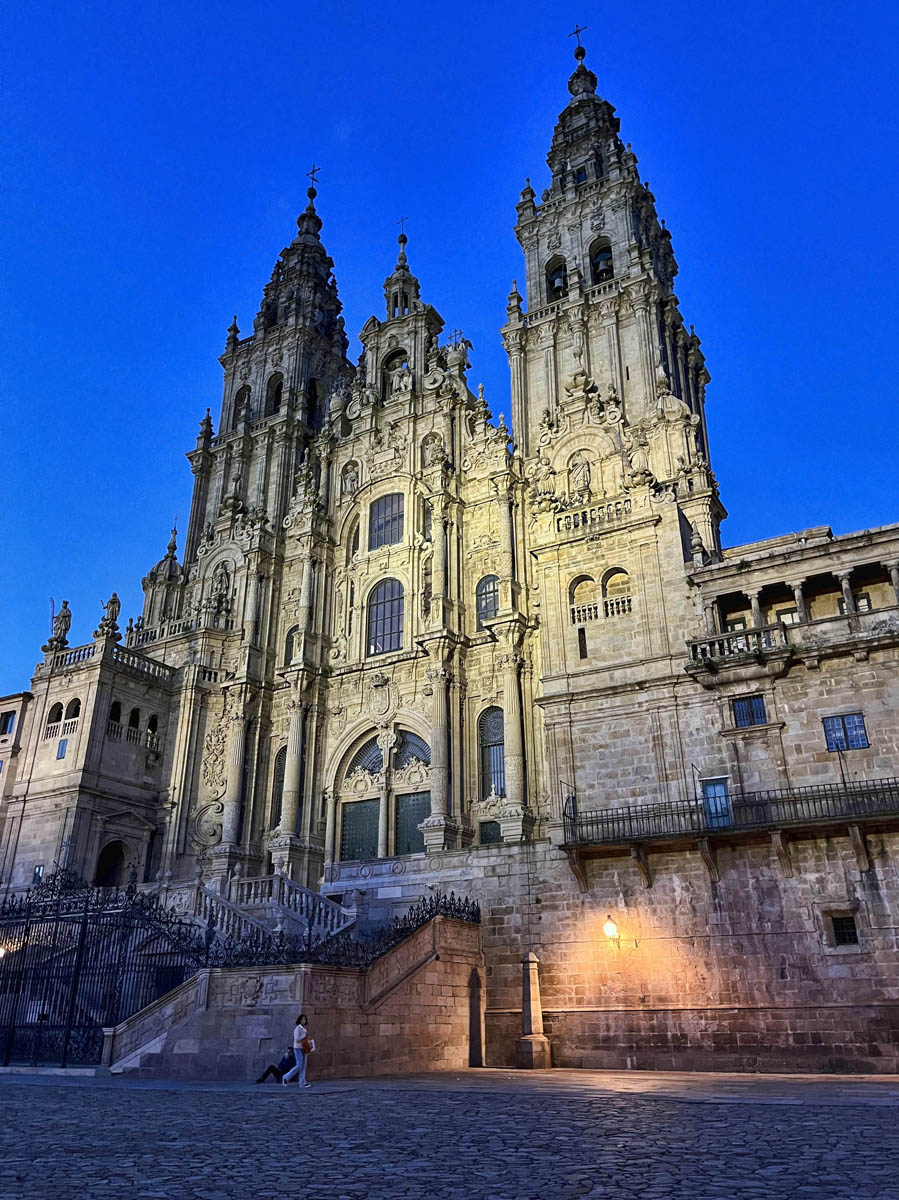
It took me several nights in attempt to stay awake until dark to get some nighttime photos. The sun did not set here until after 10:00pm, so I had to hang around until after 11pm to get a “blue hour” shot.
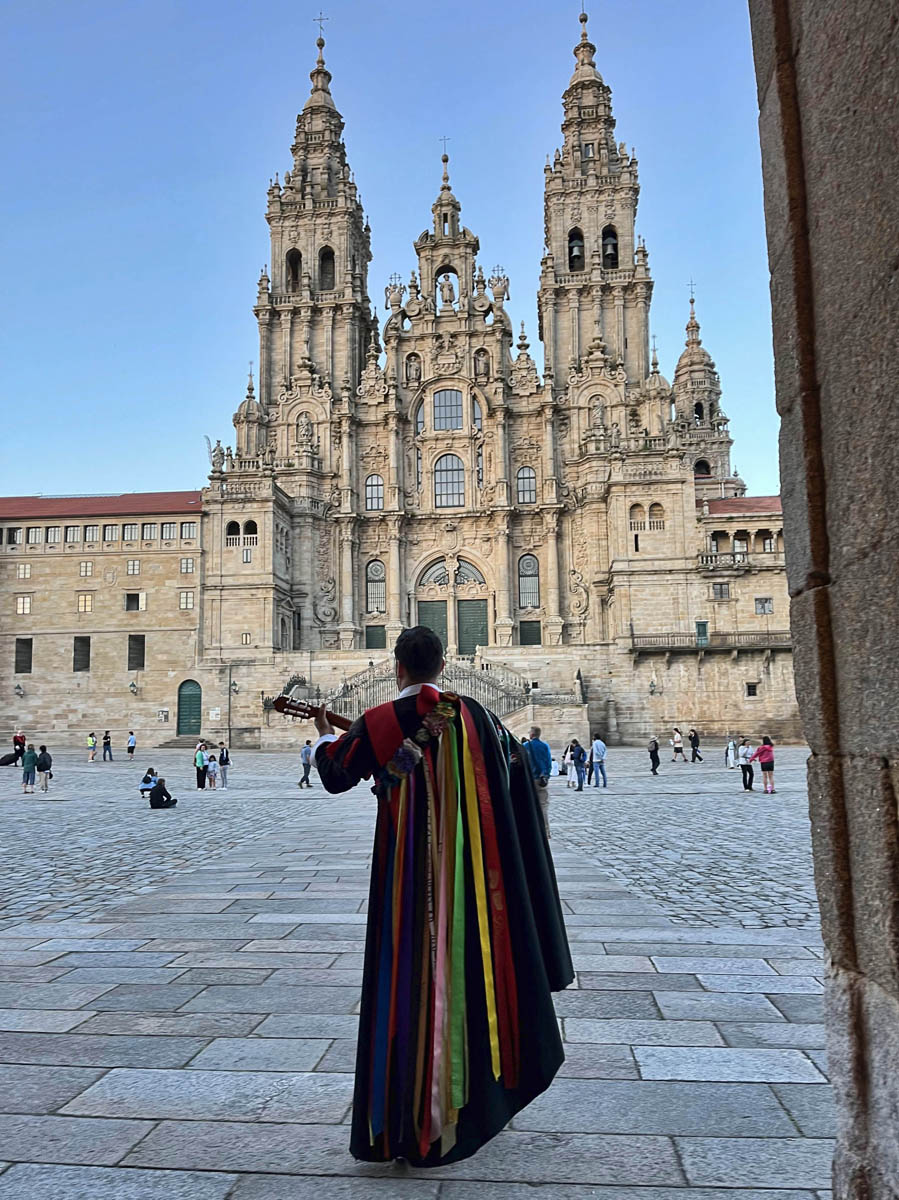
Just before sundown, the street musicians began to assemble.

Watching these musicians perform was a great way to pass the time while waiting for dark. There was lots of merry-making taking place!
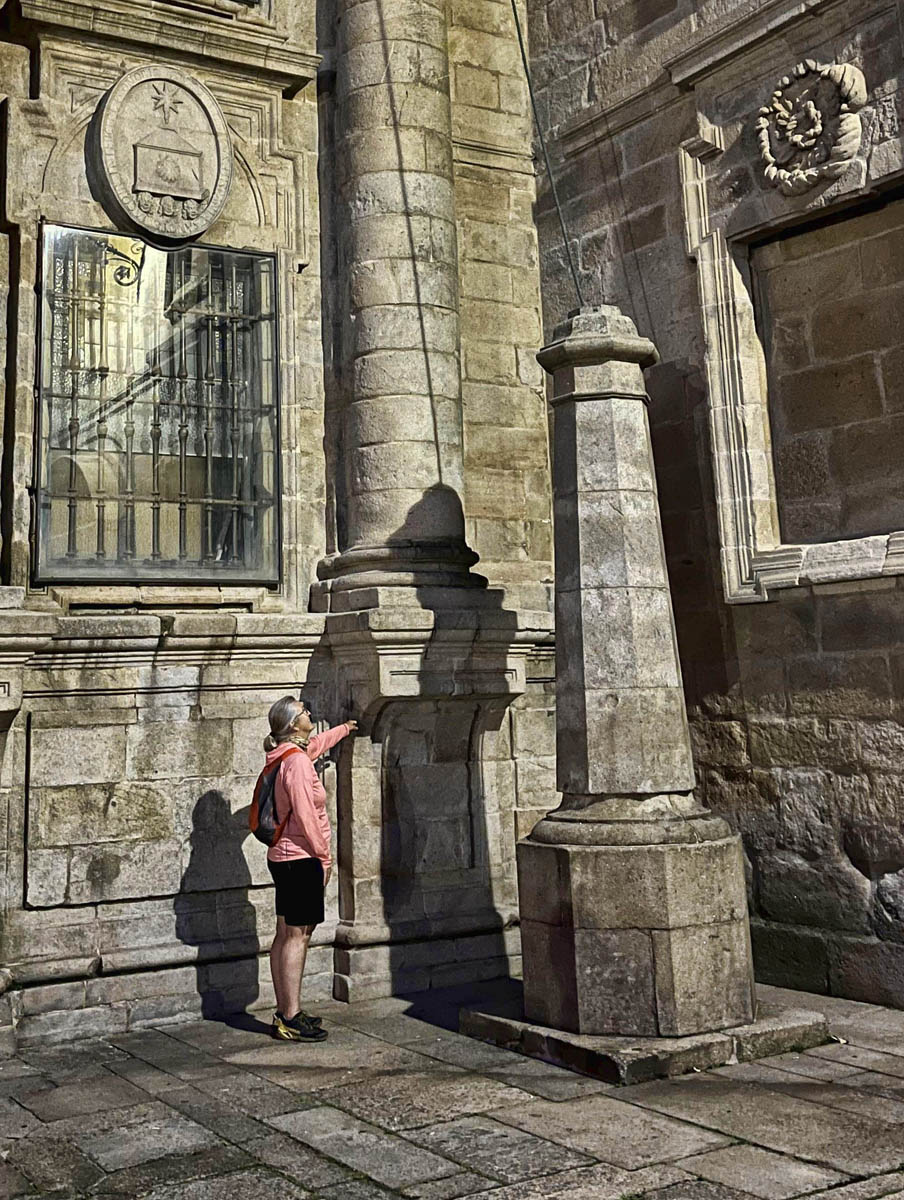
Note the shadow on the wall. This is known as the “Shadow Pilgrim,” a famous nighttime landmark where the pillar aligns with the streetlight to reflect an image of a hunched over pilgrim with traditional floppy hat, carrying his staff.
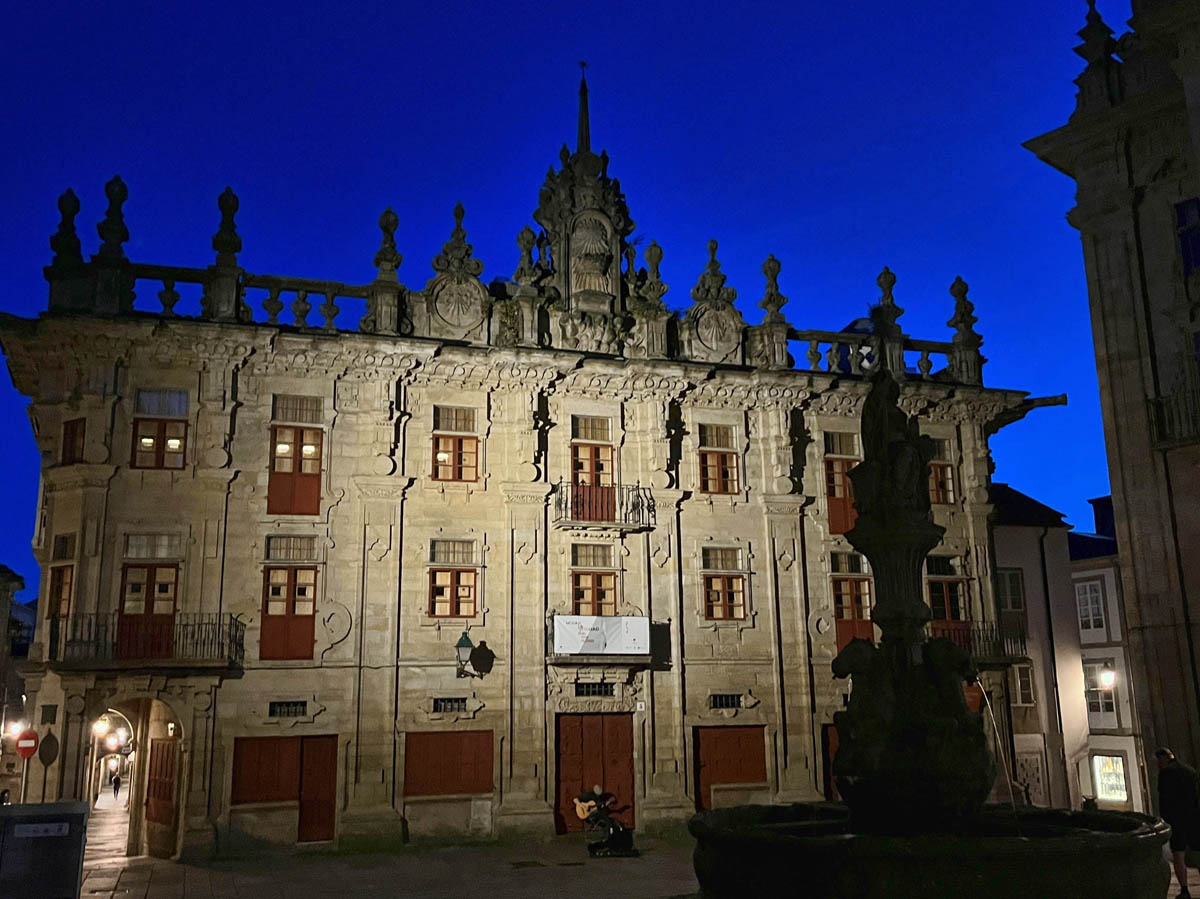
Note the lone guitarist sitting in the doorway. There are so many street musicians in Santiago that it would seem difficult to get noticed.
I spent five days in Santiago after finishing the Camino, just hanging out with people I met along the trail. We shared a lot of good meals as well as good memories. I came back to Plaza de Obradoiro daily to experience the joy of the homecoming over and over again.
Should you ever plan a trip to Spain, I highly recommend the town of Santiago, regardless of whether you have an interest in the Camino. The old town is beautiful with its gorgeous historic “old world” architecture, the glorious cathedral, museums, lively street entertainment, and fantastic and affordable food and wine. Definitely a place that feels like coming home.

This is the worst photo I took on the Camino, yet it is my favorite. Several days after I arrived in Santiago, it came a “gully-washer.” The rain was pouring down so hard, it was shooting out of the cathedral gutters like massive fire hoses. This lone unfortunate pilgrim wearing his red poncho happened to time his arrival during the worst rainstorm I had seen in two months, yet he walked into the square victorious. He faced the cathedral, raised is walking poles high in the air, and let out a ferocious roar that echoed off the walls of the buildings around the square. I felt he embodied the unflappable spirit of the Camino.
Thanks to all who followed along with me on this journey, both in real time and in reflection. It was an honor to have you along for the walk, and I am grateful for your support.
“Blessed are you, Pilgrim, if you discover that the true Camino begins at its end.” (Poster on the wall of the Pilgrim’s House, Santiago)
